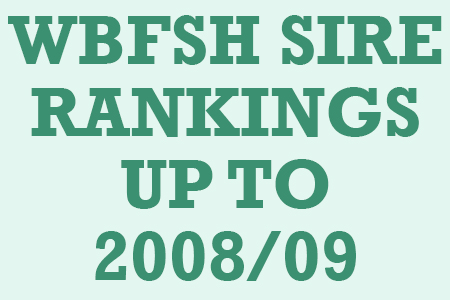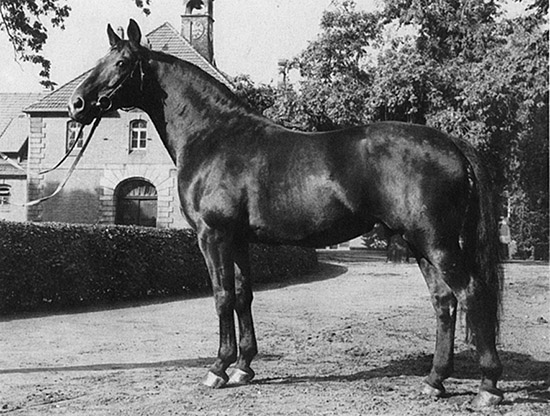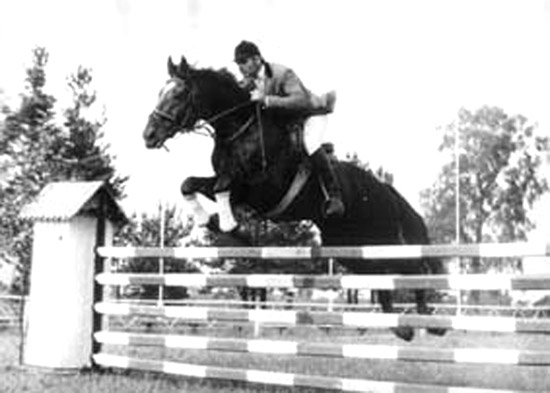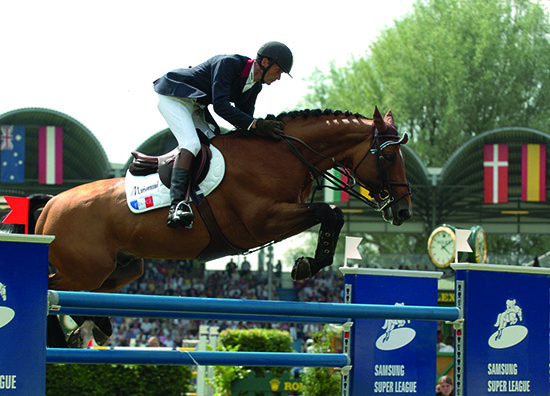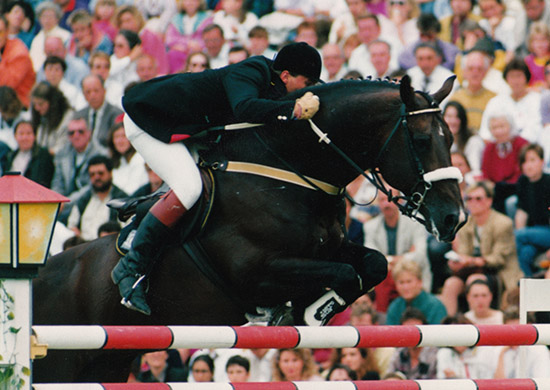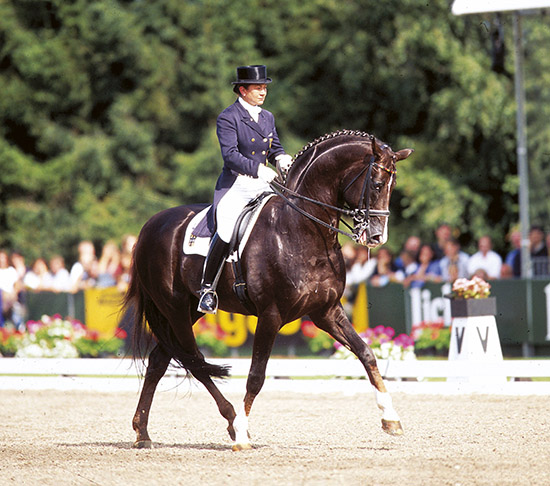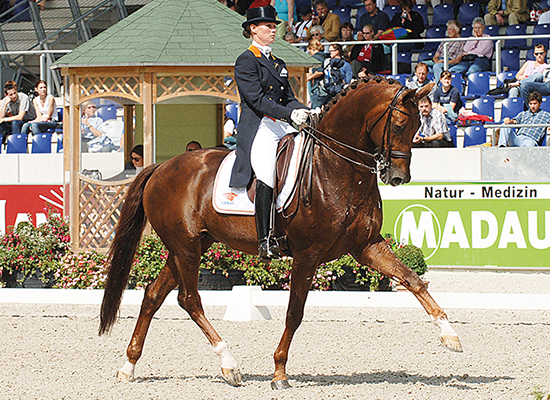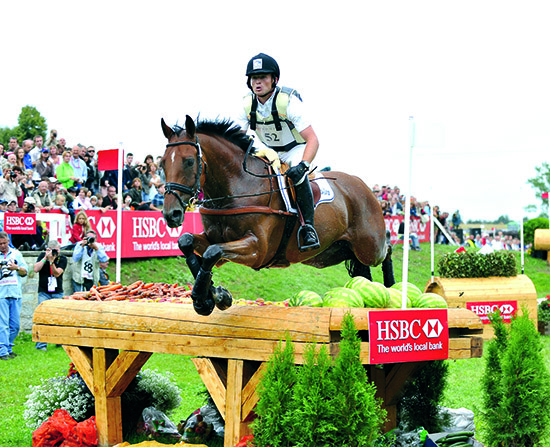By Christopher Hector
The World Breeding Federation for Sport Horses produced stallion top ten rankings in the first WBFSH International Breeding Guide, 1995/96. While the jumping standings were fine, the WBFSH dressage standings were always a little suspect, and tended to favor the sires of one very successful competitor – thus in that first handbook, Graditz, the sire of Gigolo, was listed as the 6th most successful sire in the world for the period 1990-95, solely on the basis of Gigolo’s success.
Graditz – the best dressage sire in the world?
The situation was even more absurd in the rankings for the 2000/2001 season, where Rebus – sire of the redoubtable Rusty – was put forward as the World’s number one dressage sire!
Even more absurd – Rebus
The standings appeared in the CD editions of the WBFSH breeding guide but still did nothing to inspire confidence. The 2002/3 dressage sires top ten contained three stallions, all of whom had made it on the basis of one clever foal: Freudentanzer, Argument and Tiro. The next year’s top ten had Rubinstein and Donnerhall in the top two spots, but the list still featured three one hit wonders – Rebus, Bon Bonaparte and Tiro.
When the WBFSH and BCM went their separate ways, the rankings disappeared and there was talk of a committee being formed to re-examine the formula.
However, the German equestrian journalist, Jörg Savelsberg kept the rankings going, taking the results of the 300 best competitors in each of the three Olympic disciplines to make his own sires’ rankings, which were published each year in Horse International. Jörg’s much simpler formula seems to have eliminated the one-hit wonders from his showjumping and dressage lists.
In 2007, Jörg’s top ten dressage sires were: Donnerhall, Warkant, Weltmeyer, Lauries Crusador xx, Florestan, Flemmingh, Rubinstein, Ehrentusch, Wanderer and Master. I guess if you take an interest in dressage you’d probably come up with a list much like this one without using a calculator…
The top ten in showjumping were: Darco, Contender, Quidam de Revel, Cassini I, Burggraaf, Papillon Rouge, Indorado, Cavalier Royale, Libero H and Guidam. Again, most fans of the sport would come up with a similar list.
It is interesting that in the same year, another journalist, this time the Frenchman, Bernard le Courtois (who is also a major stallion keeper, and breeder of jumping horses) also set out to come up with his ranking of the world’s top 75 jumping stallions in 2006. Taking the FEI recorded results of the world’s top 2515 jumping horses at international competitions, Bernard produced a remarkably similar top ten: Quidam de Revel, Carthago, Darco, Cassini I, Contender, Burggraaf, Papillon Rouge, Concorde, Libero H and Indoctro. The le Courtois rankings appear in the French publication, Monneron 2007-2008.
The following year, the Monneron 2008 / 2009, top 100 list was much the same. The top twenty goes 1. Darco; 2. Quidam de Revel; 3. Burggraaf; =4. Carthago & Heartbreaker; =6. Cassini I & Concorde; 8. Papillon Rouge; 9. Contender; =10. Calido I & Libero H; 12. Indoctro; 13. Caretino; 14. Acord II; 15. Voltaire; =16. Argentinus & Indorado; = 18. Calvados & Cento = 20. Le Tot de Semilly & Ramiro.
However in the 2008 / 2009 Monneron, Bernard has further refined his rankings, introducing another list based on the points average of the stallion’s progeny. Bernard took into account only those stallions with a minimum of three progeny with an average of 100 points – there were 84 stallions that fell into this category.
Bernard notes the danger inherent in this ranking: “Naturally this system, as with the previous one, also has its disadvantages. A stallion with three products, one of which is exceptional, will come out with a high average. But no system is perfect!”
Dollar du Maurier comes up tops
The top horse is Dollar du Maurier and this immediately demonstrates how useful this formula is in bringing attention to outstanding stallions who have not attracted many mares…
“The leader of this classification is the SF World Champion, Dollar du Murier (Jalisco B / Uriel) wrongly set aside by the French breeders. Dollar du Murier served only around 30 mares in 2007… incredible! But admittedly, his owner never put much effort into promoting him and attracting the breeders. He probably thought (and rightly so) that his Dollar had been an exceptional performer and that everybody should have known this. Unfortunately ‘customers’ move on, and the ‘new’ breeders did not necessarily know Dollar at the height of his glory, five or six years ago. The others will probably need to be reminded of him on a regular basis. And it’s true that the market to choose from is so wide that well ‘managed’ newcomers sometimes seem more attractive than the sure values!”
“Dollar, as his sire before him, has a reputation of producing horses that are too difficult for amateur riders. But what stallion with a reputation for producing high-level stars also turns out riding hacks for gentrified ladies to ride in the Bois de Boulogne? There are many other stallions for this purpose.”
“Dollar has to be taken as he is… a star capable of producing stars! His sire, Jalisco was the same; was it not said of Jalisco that he could turn out a Grand Prix horse, or a hunter… but nothing between the two.”
The top 20 horses on this list are: 1. Dollar du Murier (Jalisco B) average = 413.6; 2. Calato (Capitol I) = 397; 3. Silvio I (Sandro) = 375; 4. Guidam (Quidam de Revel) =353.16; 5. Palestro II (St Brendan xx) = 335.33; 6. Irco Marco (Irco Polo) = 309.4; 7. Le Prince de Thurin (Uriel) = 286.66; 8. Escudo (Espri) = 265; 9. Ohio v Padenbore (Quidam de Revel) = 264.6; 10. Lasino (Landgraf I) = 250.33; 11. Cortez (Cor de la Bryère) = 248.6; 12. Mr Blue (Couperus) = 248.5; 13. Feliciano (Irco Marco) = 248.33; 14. Apache d’Adriers (Double Espoir) = 239.28; 15. Peter Pan (Pilot) = 228.33; 16. Nabab de Reve (Quidam de Revel) = 235.23; 17. Laudanum xx (Boran) = 222.16; 18. Grosso Z (Goliath) = 221; 19. Argentinus (Argentan) = 209.93; 20. Cash (Cor de la Bryère) = 200.85.
The world breeding community should be grateful to Bernard le Courtois for pushing the boundaries of our awareness, yet again.
At the end of 2007, the WBFSH once again produced stallion standings, and this time they seem to have adopted a simple system of calculations based on the rankings of FEI performance results, very similar to the method of Jörg Savelsberg, and without all the multipliers and special factors that made their earlier standings so difficult to follow.
Darco tops the jumping standings…
The jumping stallion ranking from 1st to 15th is:
Darco (5722 points); Quidam de Revel (5585), Papillon Rouge (4135), Libero H (4098), Indoctro (4098), Contender (3981), Argentinus (3909), Caretino (3422), Cassini I (3259), Burggraaf (3101), Nabab de Reve (3057), Carthago (2889), Heartbreaker (2505), Calato (2387) and Le Tot de Semilly (2376). Which is pretty much how we would expect the standings to be…
and Donnerhall heads up the dressage
The dressage top 15 goes:
Donnerhall (10538), Weltmeyer (6687), Jazz (6523), Lauries Crusador (5156), Warkant (4905), Davignon (4669), Master (4144), Ferro (4001), Ehrentusch (3884), Florestan (3859), Rubinstein (3409), Jet Set D (3069), Wanderer (2768), Bellini (2693) and Bek xx (2669).
I guess we are starting to worry by the end of the list but the truth is that while there are a very very large number of proven jumping stallions, the dressage lines are only now consolidating themselves, so perhaps the depth is still not there. It is interesting that the top ten dressage horses are represented by a total of 71 representatives currently competing, an average of 7.1 competitors per stallion. The leader on the dressage rankings, Donnerhall, has 16 representatives – however it takes a lot more successful progeny to make it as a jumping sire. Darco, in first place, has points from 46 progeny and the average number of international representatives per top ten jumping stallion is 27.2.
The following year, the 2008 dressage top fifteen reads:
- Jazz 12397; 2. Donnerhall 10294; 3. Weltmeyer 8027; 4. Rubinstein 5146; 5. Ferro 4897; 6. Flemmingh 4660; 7. Rohdiamant 4086; 8. Ehrentusch 3895; 9. Gribaldi 3746; 10. Lauries Crusador xx 3707; 11. Florestan 3234; 12. Warkant 3202; 13. Contango 3172; = 14. Wanderer & Jetset D 2835.
There wasn’t much movement on the 2008 jumping sires rankings – Darco is still the number one.
- Darco 8411,73; 2. Quidam de Revel 6913,43; 3. Argentinus 4854,72; 4. Concorde 4447,00; 5. Nabab de Reve 4359,33; 6. Caretino 4177,43; 7. Burggraaf 3924,95; 8. Libero H 3781,95; 9. Indoctro 3547,22; 10. Papillon Rouge 3463; 11. Cassini I 3281,67; 12. Voltaire 3164,00; 13. Calido 3120,45; 14. Indorado 3054,5; 15. Polydor 3038,5
Once again there were no surprises when the WBFSH Rankings 2008-2009 were released.
I guess anyone with an interest in equestrian sport would be well aware that the Dutch Studbook had had a very successful year, and the proof is in the rankings: the KWPN is number one for jumping and number one for dressage, and they even crept into fifth place in the Eventing rankings. Obviously the Dutch breeders have been getting it right, and their open and flexible policy – perhaps even their insistence of soundness – is paying dividends – but… well the ‘but’ is that there is always a worry about the influence on the riders in producing these rankings…
Back in the days when the formula used to calculate the WBFSH rankings was seriously whacko, and a stallion like Rebus could be crowned World Number 1 Dressage Sire, on the basis of a freak like Rusty, there was always the feeling that the credit really belonged to the remarkable skills of Ulla Salzgeber rather than the genetics of her gelding. With Rusty the clone stallion about ready to hit the production line, I guess that question will answer itself. During the year in which the latest standings were calculated there were a number of well publicized issues between the German FN and the German elite riders and as a result, some of their top competitors did not compete for their team, and this is obviously affected the Breeding rankings. The KWPN won the dressage standings by just over 500 points, but Isabell Werth was suspended (and pregnant) since half way through the year, missing out on Aachen and, of course, the European Championships. Had her two, Satchmo and Warum Nicht competed, would this have produced sufficient points to push the Hanoverians into first place yet again? It would have only taken three placings for the Hanoverian pair for Hanover to have triumphed once again.
Certainly the Dutch stallion keepers have proven themselves mighty adept at sniffing the winds of change and moving fast to take grab the advantage. While many Germans had written off the Trakehner as hopelessly compromised by a breeding fashion for the beautiful and useless, the Dutch seem to have nosed the Trakehner revival and moved swiftly. Three of their winning team are by German Trakehner stallions. Painted Black and Totilas, by the Dutch owned, Gribaldi (Kostolany / Ibikus), and Nadine Exquis, by Anky van Grunsven’s Grand Prix horse, Partout (Arogno / Donauwind).
I guess it comes as some relief to the Hanoverian breeding authorities that after several years in which their dressage team has been dominated by horses obviously bred for a jumping career, this time, 50% are by the dressage stallions Weltmeyer, Wenzel and Donnerhall.
The third placed Danish Warmbloods, once very much the poor relations of their Swedish neighbours, continue to proclaim that they are a force to be reckoned with, again, largely because of their open breeding policy and willingness to buy the best the Germans have to offer.
Oldenburg takes fourth, followed by the Swedes and the Westfaliens.
The Dutch head the showjumping rankings and the top horse – Hickstead has a pedigree that is more or less a history of Dutch jumping breeding. All the great names are there: Nimmerdor, Courville, Le Val Blanc, Lucky Boy, Joost, Le Mexico and Amor. The rest of their team demonstrates the wisdom of finding the best of the best where ever they were born with Almé, Ramiro, Pilot, Uriel and Landgraf, all contributing.
The French take second place, and this once again underlines the crucial influence of Ibrahim, mainly through his son, Almé. The most successful of their team has been Itot du Chateau, by Le Tot de Sémilly but out of a Galoubet mare, with yet another cross of Ibrahim on the mare line. One of the stars at the European Championships, Kraque Boom* Bois Margot – a son of Jalisco – was the next most important contributor, followed by Jubilee d’Ouilly (by Palstro II, out of an Ibrahim mare), Love Affair by the Galoubet son, Quick Star, Kellemoi de Pepita – by Voltaire by out of an Almé mare – and Jalisca Solier, by Alligator Fontaine but out of a Jalisco mare.
Even the fourth placed Belgian Warmblood team is rich in the blood of Almé with Tresor (Papillon Rouge) and two by Nabab de Reve: Vigo d’Arsouilles and Walnut de Muze Exquis. Luckily for local pride, one is by that most famous of Beligan sires, Darco, and another by his son, Nonstop.
The third placed team from Holstein is the familiar mix of Cor de la Bryère, Capitol and Landgraf. The leading representative is Cash (a popular name with showjumpers) but this particular Cash combines all the big three. He is by Carthago – a combination of Capitol and Cor de la Bryère, and out of a mare by Landgraf. He is followed by Cristallo with a double cross of Cor de la Bryère. Then comes Cadett by ‘Corde’ out of a Capitol mare, followed by the Landgraf grandson, Lacroix and Lambrasco, another grandson, by Libero by Landgraf, and out of a grand-daughter of Corde. The team is completed by Euro Champs star, Corradino by Corrado (Cor de la Bryère / Captiol) out of a mare who combines the blood of Sandro and Landgraf, with Corde’s sire, Rantzau xx.
On the jumping sires rankings there has not been a lot of movement. Darco is still number one and Quidam de Revel, number two. Argentinus, third last year, drops right out of the top 30, while Carthago moves up from 17th to 3rd. Fourth – Caretino, 5th – Nabab de Reve, 6th – Libero H, 7th – Concorde, 8th – Animo, 9th – Heartbreaker, 10th – Calvaro, 11th – Mr Blue (up from 27th and sadly deceased), 12th – Voltaire, 13th – Burggraaf, 14th – Calido, 15th – Indoctro. For all the relatively modest third place for the Holsteiners in the studbook rankings, almost half, seven out of the top 15 stallions, are recognizably Holsteiner bred.
Jazz takes the lead in the dressage standings
For the second year running, Jazz heads up the dressage list, with Donnerhall again in second place. Weltmeyer drops from 3rd to 5th and Florestan moves up from 12th to 3rd. Rohdiamant is up four spots to 4th, with Weltmeyer and his great rival Rubinstein, 5th and 6th. Welt Hit II is up from 20th to 7th. Ferro is 8th, Master – 9th, Gribaldi – 10th, Solos Carex – 11th, Contango – 12th, Wanderer – 13th, Jet-Set D – 14th and the Danish based Holsteiner, Come Back II rounds out the 15. Despite the win for the Dutch studbook, only three of the 15 are Dutch born as against ten from Germany.
The Eventing Standings have traditionally been dominated by that well-known breeding association, Unknown, but things are improving, and out of this year’s top 30 competitors, only seven are orphans. With six in the top 30, the leading studbook is the Irish Sport Horse – this book has won the title every year since its inception, but the gap is closing. On the 2008 standings, the Irish were over 600 points in front of the 2nd placed Selle Français, with the Hanoverians a further 40 points behind the French. In 2009 the Irish won with 1332 points, second the Hanoverians with 1264, with the French, 3rd on 1227.
Last year, the Thoroughbred stallion, Heraldik was second, this year he takes first place, with two representatives in the Hanoverian team, and a staggering total of nine representatives in all. Sadly it seems Heraldik xx left no stallion son to carry on his influence. Second to the British Sporthorse, Jumbo (by an Irish Draught, Skippy out of an Irish mare by the Thoroughbred, Seven Bells). Third to the Thoroughbred, Master Imp xx, who has produced many successful Irish Sporthorses. Fourth to the Irish showjumping star, Cruising. Fifth to another Thoroughbred, Stan the Man, the sire of the horse that topped the competition standings, Michael Jung’s Luhmühlen four star winner, La Biosthetique Sam FBW (Stan the Man sired three of the five horses that took the Baden-Württemberg book into 4th place on the eventing standings.) Last year’s number one, the Irish based Holsteiner, Cavalier Royale drops to 6th – but it should be noted that this was neither an Olympic nor WEG year and many of the big guns of eventing were being rested or only lightly campaigned, next year we should see them back in action. Marie-Christine Duroy’s great competitor, Yarlands Summer Song (Trakehner on the top line, Sam Barr’s eventing breeding on the mare line) is proving a useful sire, producing the third best competitor, Le Prince des Bois. Thoroughbreds take out 8th and 9th: Primitive Rising and Amerigo Vespucci. The Trakehner, Fleetwater Opposition (sire of Yarlands Summer Song) is 10th. Voltaire is 11th, the three quarter Thoroughbred, Kiltealy Spring is 12th, followed by the US based Holsteiner, Riverman (a great-grandson of Ramiro out of a Landgraf mare), in turn followed by the Hanoverian, Sherlock Holmes, and rounding out the 15, the Thoroughbred, Rustic Amber.
Sam – number one eventer…
Rustic Amber makes the top fifteen on the basis of just one horse out of the list of 998 competitors – it is no doubt a very good horse, my friend Megan Jones’ Kirby Park Allofasudden, who added further lustre to his sire’s standings, with a second at the Adelaide 3DE**** after the rankings closed. But should Rustic Amber rate more highly than Brilliant Invader (sire of Olympic gold medalist, Ready Teddy) who finished in 24th spot, with two horses on the list, and a third, Koyuna Sunshine, listed as ‘sire unknown’. I guess the rankings are meant to give breeders an indication of where to send their mare… Sadly no longer an option in this case since Brilliant Invader died a few years back, but perhaps there needs to be a greater weighting for multiple representatives.
Looking back over the past ten years, there has not been a lot of movement on these lists, more a gradual consolidation, and given that the advent of chilled and frozen semen has concentrated breeding on fewer and fewer stallions, this is unlikely to change. The decline of the local stallion station, where the breeders used whatever stallion was sent to their district, also means that we are unlikely to see the emergence of a radical outcross, a Grande or a Duellant, would just not get mares in the current climate. There are unlikely to be huge surprises in the future…



